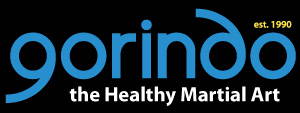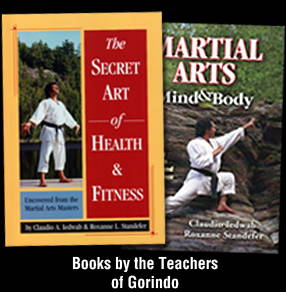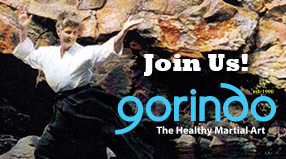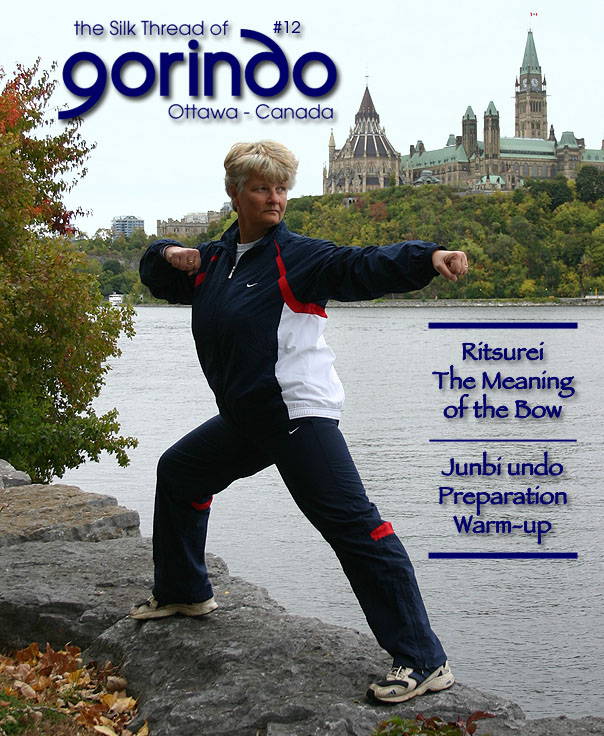
The Silk Thread of Gorindo - Ottawa - Canada
Issue 12
- The Meaning of the Bow - Ritsurei
- Junbi Undo Preparation - Warm-Up
Photo cover Roxanne Standefer sensei, October 2011, by Claudio Iedwab
Preparation - Warm-Up (Part 1)
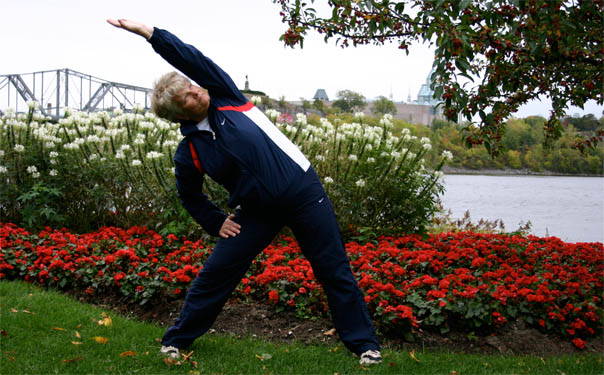
Warming-up properly is essential. It is preferred to do the warm-up without the work-out than the work-out without the warm-up.
Preparation Exercises
• The purpose of the warm-up, junbi undo, is to gently and gradually prepare your body for more strenuous exercises to follow. Warming-up properly is essential. Do not practice a technique “cold”, because it puts a tremendous stress on the muscles, joints and connectors and can lead to injuries. Increase the temperature of the body gradually with warm-up exercises and proper breathing, exhaling slowly during the effort.
• A warm-up should start gradually and slowly to get the body moving.The duration of the warm-up depends on the individual's conditioning, age and experience, the room temperature and the nature of the work-out to follow.
• The warm-up is psychological as well as physical, it helps you feel ready for the training and aware of your balance and focus, with a sense of pleasant anticipation. A higher body temperature also helps the nervous system to send and receive messages more rapidly which is useful for co-ordination and split second decisions. It also increases the speed and force of muscle contraction. Increasing the blood flow to the muscles provides more available oxygen because of the dilation of the capillaries. It also helps to remove waste products such as carbon dioxide and lactic acid, preventing or reducing the level of fatigue and muscle soreness.
• Do not confuse warming-up with stretching. The best time to perform stretching exercises for improved flexibility is after the body is well warmed-up, relaxed, and when the blood circulation is at an optimum level usually at the end of a workout. Recent studies have suggested that anything more than gentle loosening stretches at the start of a workout may actually hinder activity.
• The warm-up presented here is a basic general preparation of the body. If done properly it has sufficient duration and intensity to elevate the body temperature, gently loosen the muscles and joints, increase the breathing rhythm and cardio pulse rate and help focus the mind in the body.The time before your training should be used to gently loosen the body, shake out tensions and begin focussing the mind on the training session ahead and that time should be used constructively and responsibly.
• Do not insert your own routine. Exercises that you have learned in other places may not be appropriate for this activity. We are trying to put the body in balance.
• Be aware that once you have entered the dojo and bowed-in, conversation should be kept to a minimum other than positive friendly greetings. It is a time to get one's mind in gear for the training and not the appropriate time to complain about the traffic or your day at work or sore muscles from a hockey game with friends. Save the catch-up for the dressing room.
• Avoid extreme actions and bouncing or jerking movements that can pull muscles or ligaments very easily. Do not force the body beyond its natural limits, feel comfortable and enjoy the process.
• Avoid practicing any technique until this warm-up has been done.
Start Position

Stance: Feet double shoulder width apart, toes pointing forward, weight distributed 50% in each leg, legs straight without knees locked, spine straight, arms open out to sides.
Wrist Rotation

Stance: Start Position.
Action: Inside and outside circles with the hands, rotation of the wrists.
Duration: 10 circles of each direction.
Comment: Start with small circles and increase the size, fingers open and loose.
Elbow Rotation

Stance: Start Position.
Motion: Circles with the forearms on the frontal plane, rotation of the elbows.
Comment: Start with small circles and increase the size. Hands open and loose. Shoulders dropped and relaxed.
Shoulder Rotation

Stance: Start Position.
Motion: Slow large circles with the arms on the lateral plane, rotation of the shoulders.
Comment: Extend arms behind and in front without straining. Hands open and loose. Elbows unlocked but not bent. Do not flail arms about or drive them too vigorously, it is a gentle loosening we are trying to achieve.
Side Elongation

Stance: Start Position.
Motion: Place one hand on your hip supporting your weight as you bend the body to that side. Raise the other arm in the same line above your head and to that side, palm up. Reach for a gentle elongation of the lateral side of your body.
Comment: Exhale your air. Don’t lean forward or back.
Hamstring Elongation, Center

Stance: Begin with feet two shoulder widths apart and knees slightly bent.
Action: Gradually lower upper body toward the floor, supporting your weight with the hands resting on the legs above the knees. Keeping spine and head in line, reach down with your hands in the center until you feel a gentle tension in the back of your legs.
Level: It is not necessary for beginners to reach the floor. Continue to support the weight on the knees. If this exercise is done with proper technique, your flexibility will improve gradually. Resist spreading your feet further apart or leaning forward in order to touch the floor. By doing so you are shifting the stretch to other muscles and cheating yourself out of the chance to improve. For advanced elongation, allow the hands to slide down the legs and come together in the center. Reach gently.
Comments: Do not bounce, and do not stretch to the point of discomfort or pain. Keep the knee joint unlocked and take care not to hyperextend it. Remember to exhale as you bend down and breathe normally in the hold position. Inhale as you return to the standing position. Keep eyes open, looking down and slightly forward. Avoid bending neck out of line.
Hamstring Elongation, Individual Leg

Stance: Stand with feet two shoulder widths apart.
Action: Turn the upper body and head to a 45° angle and gradually lower the upper body, with chest moving toward the knee to the point of a relaxed stretch, allowing the hands to support the weight along the leg. Reach will vary according to state of warm-up or cool-down. Be careful to not overstretch. Keep head in line with spine, and do not bounce or twist.
Level: If this exercise is done properly, your flexibility will improve gradually. For advanced elongation grab lower on the ankle.
Comments: Do not bounce and do not stretch to the point of any discomfort or pain. Keep the knee joint unlocked and take care to not hyperextend it. Maintain spine and head position; lower chest to knee, not the head to knee. If proper position is not maintained the muscles of the back will be stretching and not the hamstrings. Remember to breathe normally in the hold position. Avoid twisting and pulling on the leg.
by Claudio Iedwab & Roxanne Standefer
Originallly published in the Gorindo Student Manual and “The Secret Art of Health & Fitness – Uncovered from the Martial Arts Masters” by Claudio Iedwab & Roxanne Standefer
©2011 Photos & Illustrations by Claudio Iedwab
- The Meaning of the Bow - Ritsurei
- Junbi Undo Preparation - Warm-Up
« Click the Subscribe link on the left
